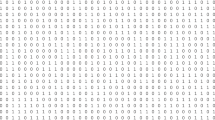Abstract
Binary formally self-dual (f.s.d.) even codes are the one type of divisible [2n, n] codes which need not be self-dual. We examine such codes in this paper. On occasion a f.s.d. even [2n, n] code can have a larger minimum distance than a [2n, n] self-dual code. We give many examples of interesting f.s.d even codes. We also obtain a strengthening of the Assmus-Mattson theore. IfC is a f.s.d. extremal code of lengthn≡2 (mol 8) [n ≡6 (mod 8)], then the words of a fixed weight inC ∪C ⊥ hold a 3-design [1-design]. Finally, we show that the extremal f.s.d. codes of lengths 10 and 18 are unique.
Similar content being viewed by others
References
Assmus, Jr., E.F. and Mattson, Jr., H.F. 1969. New 5-designs.J. Combin. Theory. 6A: 122–151.
Brualdi, R.A. and Pless, V. 1993. Greedy codes. To appearJ. Combin. Theory SerA.
Conway, J.H. and Pless, V. 1980. On the enumeration of self-dual codes.J. Combin. Theory, 28A: 26–53.
Conway, J.H., Pless, V., and Sloane, N.J.A. 1992. The binary self-dual codes of length up to 32: a revised enumeration.J. Combin. Theory. 60A:183–195.
Conway, J.H. and Sloane, N.J.A. 1990. New upper bounds on minimal distance of self-dual codes.IEEE Trans. Inform. Theory. IT-36:1319–1333.
Conway, J.H., Pless, V., and Sloane, N.J.A. 1979. Self-dual codes over GF(3) and GF(4) of length not exceeding 16.IEEE Trans. Inform. Theory. IT-25:312–322.
Delsarte, P. 1971. Majority logic decodable codes derived from finite inversive planes.Inform. Contr. 18: 318–325.
van Lint, J.H. and MacWilliams, F.J. 1978. Generalized quadratic residue codes.IEEE Trans. Inform. Theory. IT-24:730–737.
MacWilliams, F.J., Odlyzko, A.M., Sloane, N.J.A., and Ward, H.N. 1978. Self-dual codes over GF(4).J. Combin. Theory. 25A:288–318.
Mallows, C.L. and Sloane, N.J.A. 1973. An upper bound for self-dual codes.Inform. Contr. 22: 188–200.
Peterson, W.W. and Weldon, E.J. 1972.Error Correcting Codes, 2nd edition. Cambridge, Mass.: MIT Press.
Pless, V. 1972. A classification of self-orthogonal codes over GF(2).Discrete Math. 3:209–246.
Pless, V. 1989.The Theory of Error Correcting Codes, 2nd edition. New York: John Wiley and Sons.
Pless, V. and Sloane, N.J.A. 1975. On the classification and enumeration of self-dual codes.J. Combin. Theory. 18A:313–335.
Pless, V., Masley, J.M., and Leon, J.S. 1987. On weights in duadic codes.J. Combin. Theory. 44A:6–21.
Sloane, N.J.A. 1979. Self-dual codes and lattices.Proc. Symp. Pure Math. 34:273–308.
Simonis, J. 1992. The [18, 9, 6] code is unique.Discrete Math. 106/107:439–448.
Verhoeff, T. 1987. An updated table of minimum distance bounds for binary linear codes.IEEE Trans. Inform. Theory. IT-33:665–680.
Ward, H.N. 1976. A restriction on the weight enumerator of a self-dual code.J. Combin. Theory. 21A:253–255.
Author information
Authors and Affiliations
Additional information
Communicated by S. Vanstone
The author thanks the University of Illinois at Chicago for their hospitality while this work was in progress.
This work was supported in part by NSA Grant MDA 904-91-H-0003.
Rights and permissions
About this article
Cite this article
Kennedy, G.T., Pless, V. On designs and formally self-dual codes. Des Codes Crypt 4, 43–55 (1994). https://doi.org/10.1007/BF01388559
Received:
Revised:
Issue Date:
DOI: https://doi.org/10.1007/BF01388559



